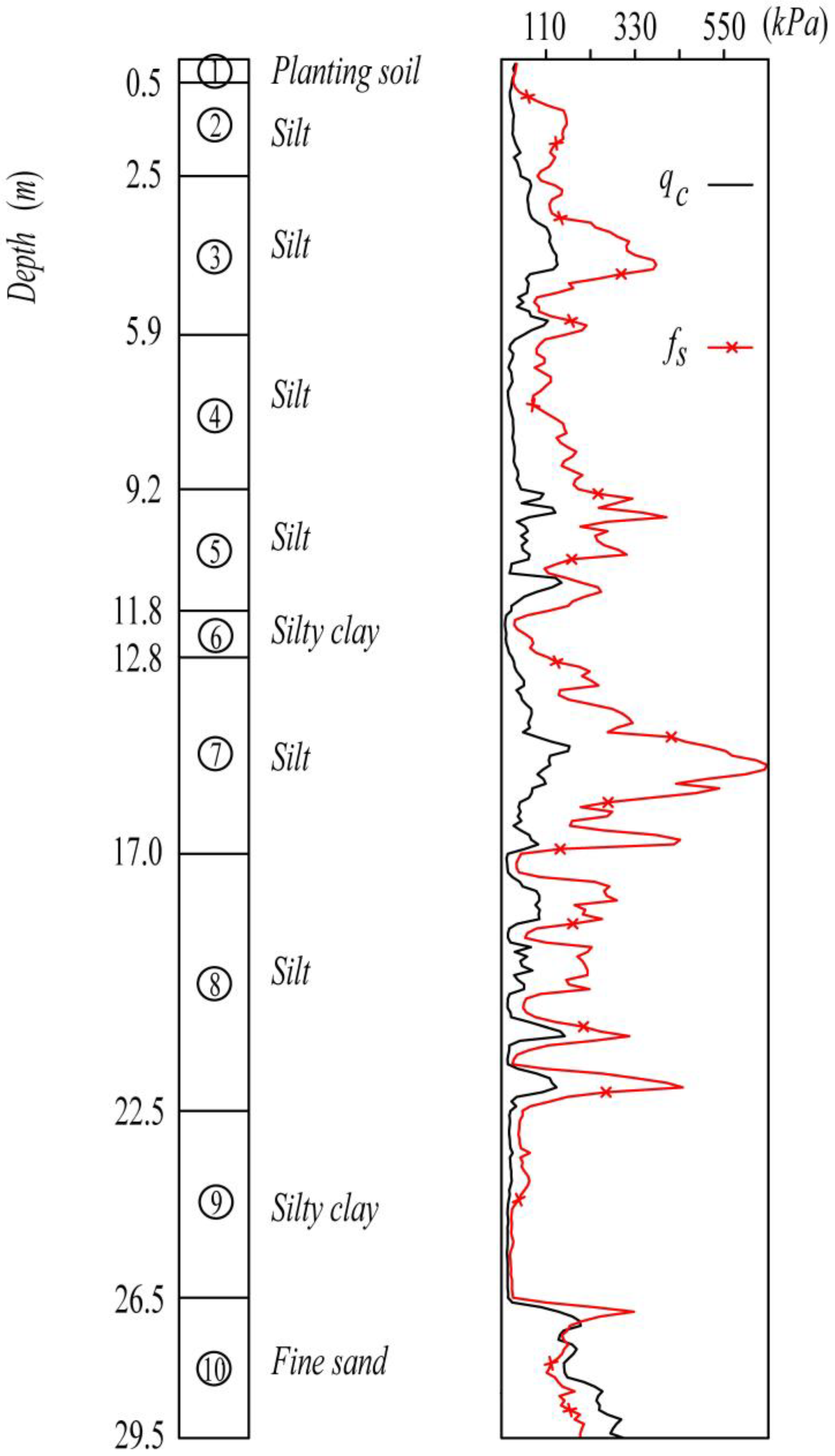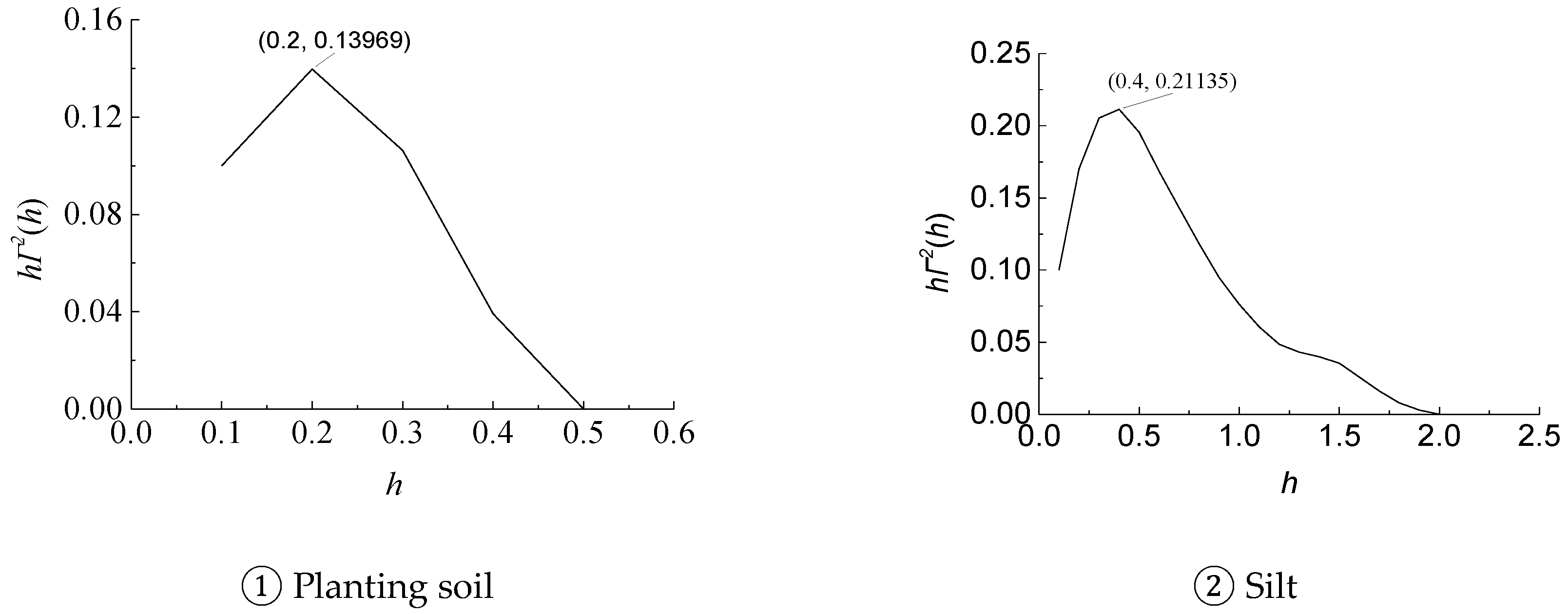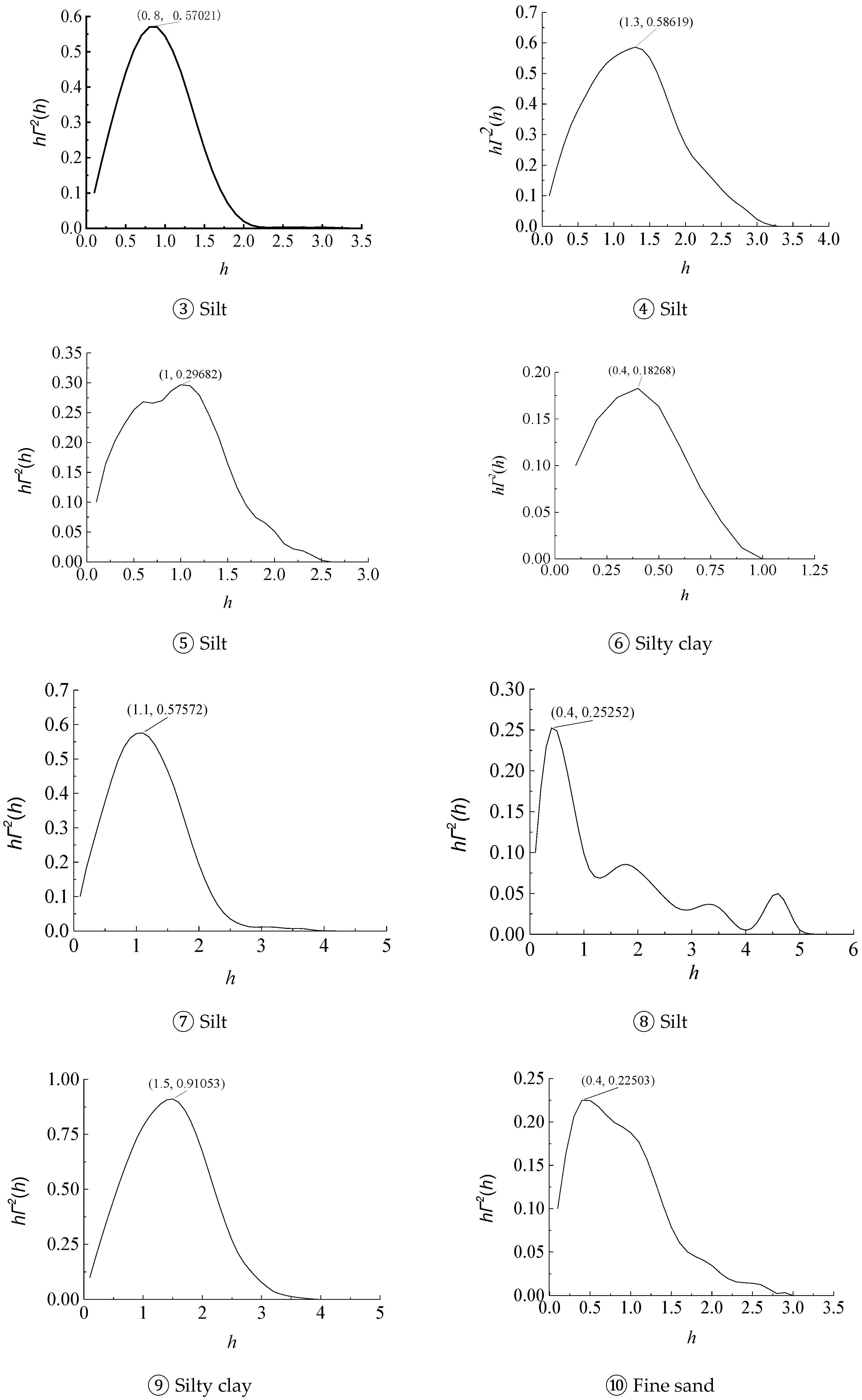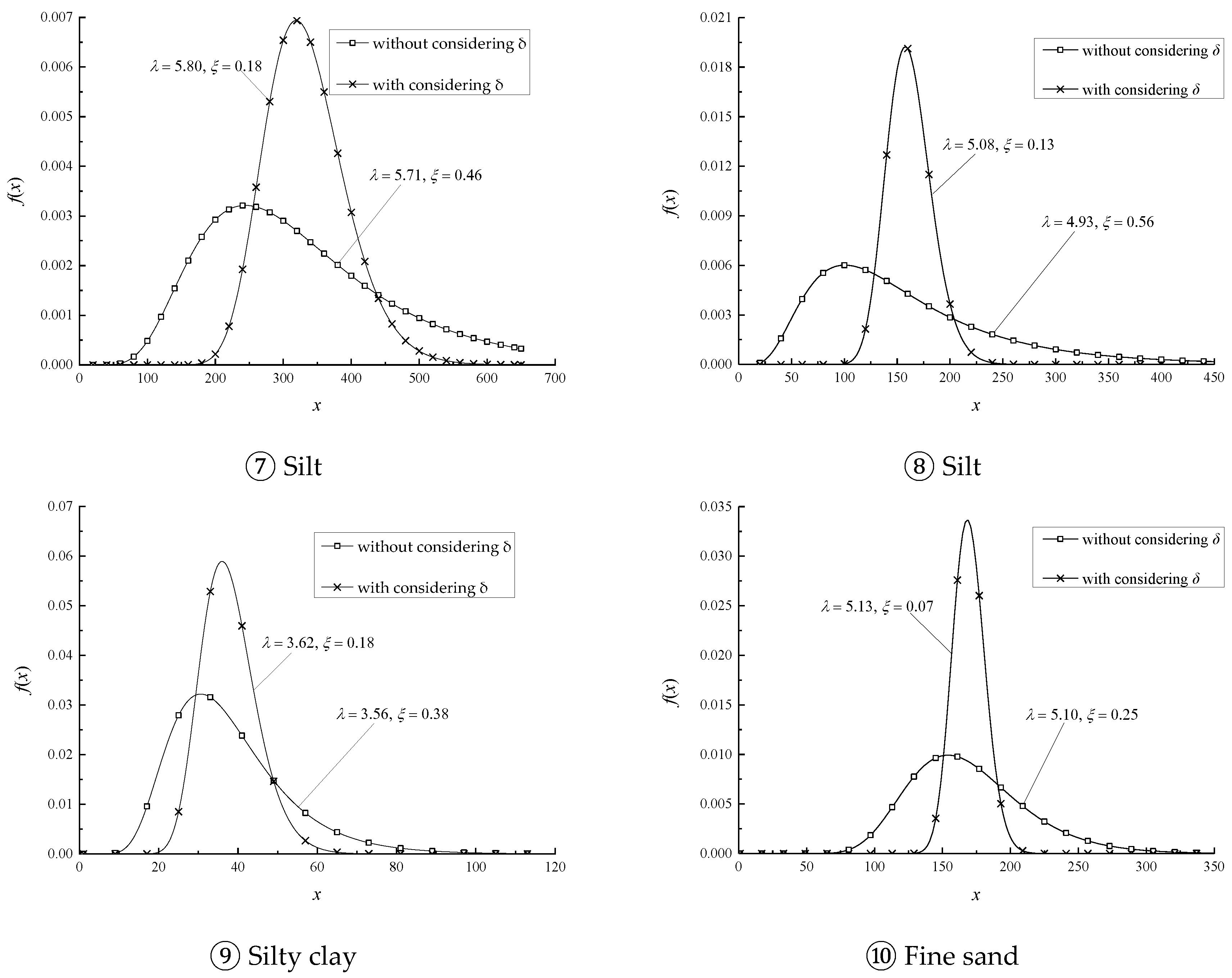Influence of Correlation Distance of Soil Parameters on Pile Foundation Failure Probability
Abstract
:1. Introduction
2. Materials and Methods
2.1. Random Field Model
- (1)
- The mean value of the soil parameter (random variable) at each point is the same;
- (2)
- The covariance of soil parameters (two random variables) at any two points is only a function of the distance between the two points.
2.2. Calculation Method of Correlation Distance
- (1)
- Select an average spatial range h = kh0, where k is a positive integer and h0 is the sampling spacing;
- (2)
- Take k = 1, 2, 3, …, in sequence and calculate the mean value of adjacent k + 1 points to form a spatial average random field xh(z);
- (3)
- Calculate the point variance σ2 and the spatial mean-variance Var[xh(z)];
- (4)
- Calculate the variance reduction function Γ2(h) = Var[xh(z)]/σ2 by Equation (3);
- (5)
- Calculate the value of hΓ2(h) and draw the hΓ2(h)~h curve;
- (6)
- Find the value of hΓ2(h) that tends to converge smoothly from the hΓ2(h)~h curve and take it as the desired correlation distance δ.
2.3. Failure Probability of Pile Foundation
2.4. Static Cone Penetration Test Data
3. Results
3.1. Distribution Characteristics of Each Layer of Soil Parameters without Considering the Influence of Correlation Distance
3.2. Average Spatial Characteristics of Each Layer of Soil Parameters Considering the Influence of the Correlation Distance
3.2.1. Calculation of the Correlation Distance
3.2.2. Average Spatial Distribution Characteristics of Each Layer of Soil Parameters
3.3. Failure Probability of Pile Foundation
4. Discussion
4.1. Influence of Correlation Distance on Parameter Distribution
4.2. Error Analysis
4.3. Action Mechanism of Correlation Distance
5. Conclusions
Author Contributions
Funding
Institutional Review Board Statement
Informed Consent Statement
Data Availability Statement
Acknowledgments
Conflicts of Interest
References
- Khalid, U.; Rehman, Z.u.; Mujtaba, H.; Farooq, K. 3D response surface modeling based in-situ assessment of physico-mechanical characteristics of alluvial soils using dynamic cone penetrometer. Transp. Geotech. 2022, 36, 100781. [Google Scholar] [CrossRef]
- Ijaz, Z.; Zhao, C.; Ijaz, N.; Rehman, Z.u.; Ijaz, A. Spatial mapping of geotechnical soil properties at multiple depths in Sialkot region, Pakistan. Environ. Earth Sci. 2021, 80, 787. [Google Scholar] [CrossRef]
- Ijaz, Z.; Zhao, C.; Ijaz, N.; Rehman, Z.u.; Ijaz, A. Novel application of Google earth engine interpolation algorithm for the development of geotechnical soil maps: A case study of mega-district. Geocarto Int. 2022, 2138566. [Google Scholar] [CrossRef]
- Huang, Y.; He, Z.; Yashima, A.; Chen, Z.; Li, C. Multi-objective optimization design of pile-anchor structures for slopes based on reliability theory considering the spatial variability of soil properties. Comput. Geotech. 2022, 147, 104751. [Google Scholar] [CrossRef]
- Ravichandran, N.; Mahmoudabadi, V.; Shrestha, S. Analysis of the bearing capacity of shallow foundation in unsaturated soil using monte carlo simulation. Int. J. Geosci. 2017, 8, 1231–1250. [Google Scholar] [CrossRef] [Green Version]
- Sedlacek, G.; Müller, C. The European standard family and its basis. J. Constr. Steel. Res. 2006, 62, 1047–1059. [Google Scholar] [CrossRef]
- Burdekin, F.M. General principles of the use of safety factors in design and assessment. Eng. Fail. Anal. 2007, 14, 420–433. [Google Scholar] [CrossRef]
- Zhang, X.-l.; Jiao, B.-h.; Hou, B.-w. Reliability analysis of horizontally loaded pile considering spatial variability of soil parameters. Soil Dyn. Earthq. Eng. 2021, 143, 106648. [Google Scholar] [CrossRef]
- Cao, Z.; Wang, Y. Bayesian approach for probabilistic site characterization using cone penetration tests. J. Geotech. Geoenviron. Eng. 2013, 139, 267–276. [Google Scholar] [CrossRef]
- Wang, Y.; Shu, S.; Wu, Y. Reliability analysis of soil liquefaction considering spatial variability of soil property. J. Earthq. Tsunami 2022, 16, 2250002. [Google Scholar] [CrossRef]
- Qi, X.; Wang, H.; Chu, J.; Chiam, K. Effect of autocorrelation function model on spatial prediction of geological interfaces. Can. Geotech. J. 2022, 59, 583–600. [Google Scholar] [CrossRef]
- Fei, S.; Tan, X.; Lin, X.; Xiao, Y.; Zha, F.; Xu, L. Evaluation of the scale of fluctuation based on variance reduction method. Eng. Geol. 2022, 308, 106804. [Google Scholar] [CrossRef]
- Le, T.M.H.; Sánchez, M.; Gallipoli, D.; Wheeler, S. Probabilistic modelling of auto-correlation characteristics of heterogeneous slopes. Geomech. Geoengin. 2015, 10, 95–108. [Google Scholar] [CrossRef]
- Oguz, E.A.; Huvaj, N.; Griffiths, D.V. Vertical spatial correlation length based on standard penetration tests. Mar. Geores. Geotechnol. 2019, 37, 45–56. [Google Scholar] [CrossRef]
- Vessia, G.; Russo, S. Random field theory to interpret the spatial variability of lacustrine soils. Biosyst. Eng. 2018, 168, 4–13. [Google Scholar] [CrossRef]
- Yang, Y.; Tang, H.; Wang, X. Failure probability analysis of corroded RC structures considering the effect of spatial variability. Mag. Concr. Res. 2023, 75, 163–175. [Google Scholar] [CrossRef]
- Ching, J.; Phoon, K.-K.; Sung, S.-P. Worst case scale of fluctuation in basal heave analysis involving spatially variable clays. Struct. Saf. 2017, 68, 28–42. [Google Scholar] [CrossRef]
- Luo, Z.; Kim, M.; Hwang, S. Effect of soil spatial variability on the structural reliability of a statically indeterminate frame. ASCE-ASME J. Risk. Uncertain. Eng. Syst. Part A-Civ. Eng. 2021, 7, 04020048. [Google Scholar] [CrossRef]
- Lo, M.K.; Leung, Y.F.; Ku, T. Variability response function approach for foundation reliability. Probab. Eng. Eng. Mech. 2021, 64, 103129. [Google Scholar] [CrossRef]
- Kawa, M.; Bagińska, I.; Wyjadłowski, M. Reliability analysis of sheet pile wall in spatially variable soil including CPTu test results. Arch. Civ. Mech. Eng. 2019, 19, 598–613. [Google Scholar] [CrossRef]
- Wang, T.; Cao, J.; Pei, X.; Hong, Z.; Liu, Y.; Zhou, G. Research on spatial scale of fluctuation for the uncertain thermal parameters of artificially frozen soil. Sustainability 2022, 14, 16521. [Google Scholar] [CrossRef]
- Pieczyńska-Kozłowska, J.M. Comparison between two methods for estimating the vertical scale of fluctuation for modeling random geotechnical problems. Stud. Geotech. Mech. 2015, 37, 95–103. [Google Scholar] [CrossRef] [Green Version]
- Cami, B.; Javankhoshdel, S.; Phoon, K.-K.; Ching, J. Scale of fluctuation for spatially varying soils: Estimation methods and values. ASCE-ASME J. Risk. Uncertain. Eng. Syst. Part A-Civ. Eng. 2020, 6, 03120002. [Google Scholar] [CrossRef]
- Yan, S.; Guo, L. Calculation of scale of fluctuation and variance reduction function. Trans. Tianjin Univ. 2015, 21, 41–49. [Google Scholar] [CrossRef]
- Christodoulou, P.; Pantelidis, L.; Gravanis, E. A comparative assessment of the methods-of-moments for estimating the correlation length of one-dimensional random fields. Arch. Comput. Method Eng. 2020, 28, 1163–1181. [Google Scholar] [CrossRef]
- Metya, S.; Bhattacharya, G. Reliability analysis of earth slopes considering spatial variability. Geotech. Geol. Eng. 2016, 34, 103–123. [Google Scholar] [CrossRef]
- Ebrahimian, B.; Movahed, V. Application of an evolutionary-based approach in evaluating pile bearing capacity using CPT results. Ships Offshore Struct. 2016, 12, 937–953. [Google Scholar] [CrossRef]
- Luo, N.; Luo, Z. Risk assessment of footings on slopes in spatially variable soils considering random field rotation. ASCE-ASME J. Risk. Uncertain. Eng. Syst. Part A-Civ. Eng. 2022, 8, 04022028. [Google Scholar] [CrossRef]
- Homaei, F.; Najafzadeh, M. Failure analysis of scouring at pile groups exposed to steady-state flow: On the assessment of reliability-based probabilistic methodology. Ocean Eng. 2022, 266, 112707. [Google Scholar] [CrossRef]
- Feng, D. Modal analysis of beam structures with random field models at multiple scales. Adv. Civ. Eng. 2021, 2021, 8847771. [Google Scholar] [CrossRef]
- Cai, G.; Lin, J.; Liu, S.; Puppala, A.J. Characterization of spatial variability of CPTU data in a liquefaction site improved by vibro-compaction method. KSCE J. Civ. Eng. 2016, 21, 209–219. [Google Scholar] [CrossRef]
- Onyejekwe, S.; Kang, X.; Ge, L. Evaluation of the scale of fluctuation of geotechnical parameters by autocorrelation function and semivariogram function. Eng. Geol. 2016, 214, 43–49. [Google Scholar] [CrossRef]
- Liu, Y.; He, L.Q.; Jiang, Y.J.; Sun, M.M.; Chen, E.J.; Lee, F.H. Effect of in-situ water content variation on the spatial variation of strength of deep cement-mixed clay. Geotechnique 2019, 69, 391–405. [Google Scholar] [CrossRef] [Green Version]
- Liu, Z.; Marit Wist Amdal, Å.; L’Heureux, J.-S.; Lacasse, S.; Nadim, F.; Xie, X. Spatial variability of medium dense sand deposit. AIMS Geosci. 2020, 6, 6–30. [Google Scholar] [CrossRef]









| Layer Name | Lateral Friction Resistance (kPa) | Cone Tip Resistance (kPa) | ||
|---|---|---|---|---|
| Mean | Standard Deviation | Mean | Standard Deviation | |
| ① Planting soil | 32.74 | 3.20 | 2.97 | 0.34 |
| ② Silt | 118.98 | 37.51 | 3.19 | 0.84 |
| ③ Silt | 199.87 | 91.60 | 8.55 | 2.94 |
| ④ Silt | 130.32 | 37.33 | 2.79 | 0.79 |
| ⑤ Silt | 227.57 | 72.71 | 6.89 | 3.77 |
| ⑥ Silty clay | 64.79 | 24.54 | 1.33 | 0.51 |
| ⑦ Silt | 334.35 | 161.57 | 7.11 | 3.43 |
| ⑧ Silt | 161.77 | 98.89 | 5.26 | 3.87 |
| ⑨ Silty clay | 37.87 | 14.81 | 1.80 | 0.36 |
| ⑩ Fine sand | 169.55 | 43.54 | 19.76 | 6.16 |
| Layer Name | Lateral Friction Resistance | Cone Tip Resistance | ||
|---|---|---|---|---|
| λ | ζ | λ | ζ | |
| ① Planting soil | 3.48 | 0.10 | 1.08 | 0.11 |
| ② Silt | 4.73 | 0.31 | 1.13 | 0.26 |
| ③ Silt | 5.20 | 0.44 | 2.09 | 0.33 |
| ④ Silt | 4.83 | 0.28 | 0.99 | 0.28 |
| ⑤ Silt | 5.38 | 0.31 | 1.80 | 0.51 |
| ⑥ Silty clay | 4.10 | 0.37 | 0.21 | 0.37 |
| ⑦ Silt | 5.71 | 0.46 | 1.86 | 0.46 |
| ⑧ Silt | 4.93 | 0.56 | 1.44 | 0.66 |
| ⑨ Silty clay | 3.56 | 0.3772 | 0.57 | 0.20 |
| ⑩ Fine sand | 5.10 | 0.25 | 2.94 | 0.30 |
| Layer Name | Layer Bottom Depth (m) | Layer Thickness (m) | Correlation Distance (m) | |
|---|---|---|---|---|
| Calculated by Lateral Friction Resistance | Calculated by Cone Tip Resistance | |||
| ① Planting soil | 0.5 | 0.5 | 0.14 | 0.1 |
| ② Silt | 2.5 | 2 | 0.21 | 0.29 |
| ③ Silt | 5.9 | 3.4 | 0.57 | 0.50 |
| ④ Silt | 9.2 | 3.3 | 0.59 | 0.40 |
| ⑤ Silt | 11.8 | 2.6 | 0.30 | 0.17 |
| ⑥ Silty clay | 12.8 | 1 | 0.18 | 0.13 |
| ⑦ Silt | 17 | 4.2 | 0.58 | 0.52 |
| ⑧ Silt | 22.5 | 5.5 | 0.25 | 0.25 |
| ⑨ Silty clay | 26.5 | 4 | 0.91 | 0.93 |
| ⑩ Fine sand | 29.5 | 3 | 0.23 | 0.36 |
| Layer Name | Lateral Friction Resistance (kPa) | Cone Tip Resistance (kPa) | ||
|---|---|---|---|---|
| Mean | Standard Deviation | Mean | Standard Deviation | |
| ① Planting soil | 32.74 | 1.69 | 2.97 | 0.15 |
| ② Silt | 118.98 | 12.20 | 3.19 | 0.32 |
| ③ Silt | 199.87 | 37.51 | 8.55 | 1.12 |
| ④ Silt | 130.32 | 15.73 | 2.79 | 0.27 |
| ⑤ Silt | 227.57 | 24.57 | 6.90 | 0.96 |
| ⑥ Silty clay | 64.79 | 10.49 | 1.33 | 0.18 |
| ⑦ Silt | 334.35 | 59.82 | 7.11 | 1.21 |
| ⑧ Silt | 161.77 | 21.19 | 5.26 | 0.82 |
| ⑨ Silty clay | 37.87 | 7.07 | 1.80 | 0.17 |
| ⑩ Fine sand | 169.55 | 11.93 | 19.76 | 2.12 |
| Layer Name | Lateral Friction Resistance | Cone Tip Resistance | ||
|---|---|---|---|---|
| λ | ζ | λ | ζ | |
| ① Planting soil | 3.49 | 0.05 | 1.09 | 0.05 |
| ② Silt | 4.77 | 0.10 | 1.16 | 0.10 |
| ③ Silt | 5.28 | 0.19 | 2.14 | 0.13 |
| ④ Silt | 4.86 | 0.12 | 1.02 | 0.10 |
| ⑤ Silt | 5.42 | 0.11 | 1.92 | 0.14 |
| ⑥ Silty clay | 4.16 | 0.16 | 0.27 | 0.14 |
| ⑦ Silt | 5.80 | 0.18 | 1.95 | 0.17 |
| ⑧ Silt | 5.08 | 0.13 | 1.65 | 0.16 |
| ⑨ Silty clay | 3.62 | 0.18 | 0.58 | 0.10 |
| ⑩ Fine sand | 5.13 | 0.07 | 2.98 | 0.11 |
| Pile Diameter (m) | Pile Length (m) | Failure Probability (%) | |
|---|---|---|---|
| Not Considering Correlation Distance | Considering Correlation Distance | ||
| 0.6 | 21 | 24.57 | 1.196 |
| 23 | 16.662 | 0.058 | |
| 25 | 13.944 | 0.028 | |
| Pile Diameter (m) | Pile Length (m) | Confidence Interval | |
|---|---|---|---|
| Not Considering Correlation Distance | Considering Correlation Distance | ||
| 0.6 | 21 | (0.24193, 0.24947) | (0.01101, 0.01291) |
| 23 | (0.16335, 0.16989) | (0.00037, 0.00079) | |
| 25 | (0.13640, 0.14248) | (0.00013, 0.00043) | |
| Pile Diameter (m) | Pile Length (m) | Confidence Interval Length | |
|---|---|---|---|
| Not Considering Correlation Distance | Considering Correlation Distance | ||
| 0.6 | 21 | 0.00755 | 0.00191 |
| 23 | 0.00653 | 0.00042 | |
| 25 | 0.00607 | 0.00029 | |
Disclaimer/Publisher’s Note: The statements, opinions and data contained in all publications are solely those of the individual author(s) and contributor(s) and not of MDPI and/or the editor(s). MDPI and/or the editor(s) disclaim responsibility for any injury to people or property resulting from any ideas, methods, instructions or products referred to in the content. |
© 2023 by the authors. Licensee MDPI, Basel, Switzerland. This article is an open access article distributed under the terms and conditions of the Creative Commons Attribution (CC BY) license (https://creativecommons.org/licenses/by/4.0/).
Share and Cite
Liu, C.; Zhang, H.; Yuan, Y.; Zhou, A.; Liu, W.; Guo, W. Influence of Correlation Distance of Soil Parameters on Pile Foundation Failure Probability. Sustainability 2023, 15, 4298. https://doi.org/10.3390/su15054298
Liu C, Zhang H, Yuan Y, Zhou A, Liu W, Guo W. Influence of Correlation Distance of Soil Parameters on Pile Foundation Failure Probability. Sustainability. 2023; 15(5):4298. https://doi.org/10.3390/su15054298
Chicago/Turabian StyleLiu, Chao, Hongrui Zhang, Ying Yuan, Aihong Zhou, Weiwen Liu, and Wanying Guo. 2023. "Influence of Correlation Distance of Soil Parameters on Pile Foundation Failure Probability" Sustainability 15, no. 5: 4298. https://doi.org/10.3390/su15054298





